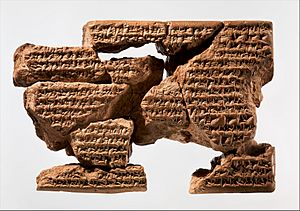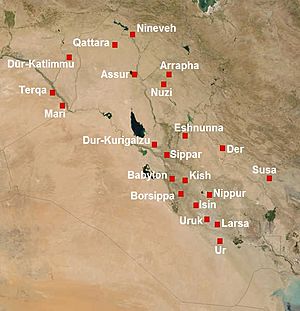Sinsharishkun facts for kids
Quick facts for kids Sîn-šar-iškun |
|
|---|---|
|
|

Letter written by Sîn-šar-iškun to his primary enemy, Nabopolassar of Babylon, in which he recognizes him as king of Babylon and pleads to be allowed to retain his kingdom. The authenticity of the letter is a matter of debate.
|
|
| King of the Neo-Assyrian Empire | |
| Reign | 627–612 BC |
| Predecessor | Aššur-etil-ilāni |
| Successor | Aššur-uballiṭ II (Assyria) Nabopolassar (Babylon) |
| Died | August 612 BC Nineveh |
| Spouse | Ana-Tašmētum-taklāk (?) |
| Issue | Aššur-uballiṭ II (?) |
| Akkadian | Sîn-šar-iškun Sîn-šarru-iškun |
| Dynasty | Sargonid dynasty |
| Father | Ashurbanipal |
| Mother | Libbāli-šarrat |
Sîn-šar-iškun was a powerful king of Assyria. He ruled from 627 BC until 612 BC. He was the second-to-last king of the Neo-Assyrian Empire. His reign ended when the capital city, Nineveh, was destroyed.
Sîn-šar-iškun became king after his brother, Aššur-etil-ilāni, died. Soon after, a general named Sîn-šumu-līšir tried to take the throne. Sîn-šar-iškun defeated him quickly. However, this caused a lot of trouble. It also allowed Nabopolassar to become powerful in Babylonia. Nabopolassar was a leader from the south. He started the Neo-Babylonian Empire. This brought back Babylonian independence. Assyria had ruled Babylon for over 100 years.
Sîn-šar-iškun tried many times to defeat Nabopolassar. But he could not stop the new Babylonian Empire. Later, the Babylonians teamed up with the Medes. The Medes were led by Cyaxares. Together, they attacked Assyria. In 614 BC, they captured Assur. This was a very important religious city for Assyria. In 612 BC, their armies attacked Nineveh. Nineveh was the capital city. It was completely destroyed. Sîn-šar-iškun likely died defending his city. His possible son, Aššur-uballiṭ II, became king after him. He tried to keep Assyria going from the city of Harran.
Even though Assyria fell during his rule, Sîn-šar-iškun was a skilled leader. He used the same battle plans as earlier Assyrian kings. He used his army wisely. Assyria's downfall was not because he was a bad king. It was because Assyria had not been attacked in its heartland for 500 years. They had no plan for such an invasion. Also, their enemies wanted to destroy Assyria completely, not just conquer it.
Contents
The Assyrian Empire and Babylonia
The Neo-Assyrian Empire was very strong in the 600s BC. It controlled much of the Near East. Assyria had a powerful army and a good government. This made it the biggest empire the world had seen.
Babylonia was south of Assyria. It was often weaker because of internal fights. Different groups lived there. These included native Babylonians, Chaldean tribes, and Arameans. Their disagreements made Babylonia an easy target for Assyria. Assyria conquered Babylon in 729 BC.
Assyria respected Babylon's long history and culture. So, Babylon remained a kingdom. It was ruled by an Assyrian king or a local ruler chosen by Assyria. Assyria learned a lot from Babylon. They shared the same language, Akkadian. Assyrians saw themselves as the "husband" and Babylon as the "wife." They loved Babylon but also wanted to control it.
Assyrian kings tried different ways to keep Babylon peaceful. Sometimes they used force. Other times, they ruled directly. They had some success with city people. But the Chaldeans and Arameans often rebelled. Babylon was too important to let go. But no matter what Assyria did, rebellions kept happening. This problem was so big that historians call it the "Babylonian problem."
Sîn-šar-iškun's Rule
Becoming King
In 627 BC, King Aššur-etil-ilāni died. His brother, Sîn-šar-iškun, became the new king of Assyria. There is no proof that Sîn-šar-iškun took the throne by force. His own writings say the gods chose him from among his brothers.
Around the same time, the king of Babylon, Kandalanu, also died. This meant Sîn-šar-iškun also became the ruler of Babylon. He ruled southern cities like Nippur and Babylon. But his rule in Babylon did not last long.
The Revolt of Sîn-šumu-līšir
Soon after Sîn-šar-iškun became king, a general named Sîn-šumu-līšir rebelled. Sîn-šumu-līšir was very important during the previous king's reign. He might have felt his power was in danger. He was a eunuch, which means he could not have children. It was very unusual for a eunuch to try to become king.
Sîn-šumu-līšir took control of some cities in northern Babylonia. This included Nippur and Babylon. He ruled for three months. Then, Sîn-šar-iškun defeated him. It is not clear if either Sîn-šar-iškun or Sîn-šumu-līšir actually called themselves "king of Babylon." This period might have been a time without a clear ruler in Babylon.
The Rise of Nabopolassar

A few months after Sîn-šumu-līšir's revolt, another rebellion began in Babylon. A leader named Nabopolassar took advantage of the trouble. He attacked Nippur and Babylon. His armies captured these cities from Sîn-šar-iškun's soldiers.
Assyria quickly fought back. In October 626 BC, the Assyrian army took back Nippur. They then surrounded Nabopolassar's forces at Uruk. But the Assyrians failed to retake Babylon. Their attack on Uruk also failed.
After this, Nabopolassar was officially crowned king of Babylon. This happened on November 22/23, 626 BC. Babylonia was now an independent kingdom again. From 625 to 623 BC, Sîn-šar-iškun's forces tried to defeat Nabopolassar. At first, they did well. In 625 BC, they took the city of Sippar. Nabopolassar failed to get Nippur back.
Another Assyrian ally, Elam, stopped paying tribute. Several Babylonian cities joined Nabopolassar. Sîn-šar-iškun led a big attack himself. He successfully recaptured Uruk in 623 BC.
Sîn-šar-iškun might have won if another problem had not happened. In 622 BC, an Assyrian general rebelled in the western provinces. This general marched on Nineveh. He took the Assyrian throne. Sîn-šar-iškun had to leave his fight in Babylonia. He went back to defeat this new enemy. He won after 100 days of civil war. But while he was away, the Babylonians took over the last Assyrian areas in Babylonia. By 620 BC, Nabopolassar had pushed the Assyrians out of Babylonia completely.
The Fall of the Assyrian Empire
Fighting in Assyria
At first, the Assyrians probably did not think losing Babylon was a big deal. They had fought Babylonians before. They thought Nabopolassar's success would be temporary.
In 616 BC, Nabopolassar entered Assyrian land for the first time. He marched his armies along the Euphrates River. He took the city of Hindanu. He also defeated an Assyrian force near Gablinu. The Assyrians quickly gathered their forces. Their ally, Pharaoh Psamtik I of Egypt, sent troops to help Sîn-šar-iškun. Psamtik wanted Assyria to stay strong. It was a buffer between Egypt and the new Babylonian and Median empires.
A joint Egyptian-Assyrian attack on Gablinu failed in October 616 BC. After this, the Egyptians mostly stayed west of the Euphrates. Both sides then pulled back. But the Babylonians now controlled the middle Euphrates. This was a big win for them. It was likely the first step in Nabopolassar's plan to protect Babylon.
In March 615 BC, Nabopolassar badly defeated the Assyrian army. He pushed them back to the Little Zab River. This meant the Babylonians now controlled land right next to the Assyrian heartland.
The Final Battles

In May 615 BC, Nabopolassar attacked Assur. This was Assyria's religious center. Sîn-šar-iškun quickly gathered his army. He counterattacked and forced Nabopolassar to retreat. Sîn-šar-iškun then surrounded Nabopolassar at Takrit. But he had to give up the siege. The war was now about Assyria defending itself. But the Assyrian army was still strong.
In late 615 BC or 614 BC, the Medes, led by King Cyaxares, entered Assyria. They conquered the area around Arrapha. They were preparing to fight Sîn-šar-iškun. We do not know why the Medes suddenly attacked. Maybe the war between Babylon and Assyria affected their economy.
In July or August 614 BC, the Medes attacked Nimrud and Nineveh. They captured the city of Tarbisu. Then they surrounded Assur. The Medes captured Assur. They looted it and killed many people. This brutal attack shocked everyone in the Near East. Even the Babylonian records said the Medes were too cruel.
Nabopolassar arrived at Assur after it was already being looted. He met Cyaxares. They became allies and signed a treaty against Assyria. To seal the deal, Nabopolassar's son, Nebuchadnezzar II, married Cyaxares's daughter, Amytis of Babylon. Winter came, so both armies went home. They planned for more attacks next year. The Assyrians did not seem to understand how serious their situation was. They did not prepare defenses.
In 613 BC, Sîn-šar-iškun went on the attack. He tried to keep his enemies out of Assyria. He attacked Nabopolassar's forces in the middle Euphrates. Sîn-šar-iškun saved a city that was under attack. But Nabopolassar's army retreated before a big battle. Around this time, Sîn-šar-iškun finally realized the danger. He sent a letter to Nabopolassar. He asked for peace. He pleaded with Nabopolassar to stop the fighting. But Nabopolassar was not interested. Sîn-šar-iškun had waited too long. Nabopolassar replied that he would destroy Nineveh completely.
In April or May 612 BC, the combined Medo-Babylonian army marched on Nineveh. Sîn-šar-iškun gathered his forces for a final stand. But the city was huge, and he had little chance. From June to August 612 BC, the Medo-Babylonian army surrounded Nineveh. In August, they broke through the walls. The city was brutally looted and destroyed. Assyrian king statues were damaged. Many people were killed. The entire city was burned to the ground. Sîn-šar-iškun is believed to have died defending Nineveh.
What Happened Next
Succession and the End of Assyria

With Assur and Nineveh destroyed, the Assyrian Empire was mostly gone. Sîn-šar-iškun was followed by another Assyrian king, Aššur-uballiṭ II. He might have been Sîn-šar-iškun's son. Aššur-uballiṭ set up his rule in Harran in the west.
Assur was destroyed, so Aššur-uballiṭ could not have a traditional coronation. He could not be officially made king by the god Ashur. So, his people saw him as the rightful ruler, but still as a "crown prince," not a full king. To the Assyrians, Sîn-šar-iškun was the last true king.
Aššur-uballiṭ ruled Harran for only three years. He fled when Nabopolassar's army came in 610 BC. He tried to get Harran back in 609 BC with Egyptian help. But he failed. After this, Aššur-uballiṭ and the remaining Assyrians disappear from history.
Why Assyria Fell
Some people thought Assyria fell because of a civil war. They believed Sîn-šar-iškun fought his brother for the throne. But there is no proof of this. There were small revolts when both brothers became king. But these were quickly dealt with. So, a long civil war was probably not the reason Assyria fell.
The main reason for Assyria's collapse was the "Babylonian problem." Assyrian kings had struggled with rebellions in the south for a long time. They tried many ways to stop them. But rebellions kept happening. Nabopolassar's revolt was the last in a long line of these uprisings. Sîn-šar-iškun tried for years to stop it, but he failed. This led to his kingdom's downfall.
The new Babylonian Empire, combined with the rising Median Empire, destroyed Assyria. Assyria had tried for years to stop the Medes from uniting.
It might seem like Assyria lost because its army was weak or its king was bad. But there is no evidence that Sîn-šar-iškun was a poor ruler. Assyria was not ready for attacks on its homeland. It had not been invaded there for 500 years. They had no defense plan because they never needed one. Sîn-šar-iškun fought using traditional Assyrian methods. He supported rebellions in enemy lands. He used clever maneuvers. He focused on attacking the enemy. He seemed like a skilled military leader. In a normal war, he might have won. But he was not ready to defend against an enemy that was stronger and wanted to destroy his country.
See also
 In Spanish: Sin-shar-ishkun para niños
In Spanish: Sin-shar-ishkun para niños

